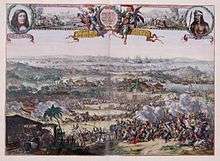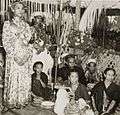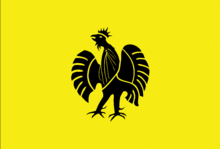Sultanate of Gowa
| Sultanate of Gowa Baté Salapang ᨅᨈᨙᨔᨒᨄ | ||||||||||||
| Part of Indonesia | ||||||||||||
| ||||||||||||
|
| ||||||||||||
 | ||||||||||||
| Capital | Sungguminasa | |||||||||||
| Languages | Makassarese | |||||||||||
| Religion | Sunni Islam | |||||||||||
| Government | Monarchy | |||||||||||
| Sultan | ||||||||||||
| • | 1300 | Tumanurung | ||||||||||
| • | 1653-1669 | Sultan Hasanuddin Tuminanga ri Balla'pangkana | ||||||||||
| • | 1946-1978 | Sultan Muhammad Abdul Kadir Aiduddin | ||||||||||
| • | 2014-Present | Sultan Kumala Idjo Batara Gowa | ||||||||||
| History | ||||||||||||
| • | Established | 14th century | ||||||||||
| • | Dissolution of Sultanate | 1945 | ||||||||||
| Currency | No official currency, the Barter system was used | |||||||||||
| ||||||||||||
| Today part of | | |||||||||||

Sultanate of Gowa (sometimes written as Goa; not to be mistaken with Goa in India), was one of the great kingdoms and the most successful kingdom in the South Sulawesi region. People of this kingdom come from the Makassar tribe who lived in the south end and the west coast of southern Sulawesi.
History
Before the establishment of the kingdom, the region had been known as Makassar and its people as Suku Makassar (tribe of Makassar).[1] The history of the kingdom can be divided into two eras: pre-Islamic kingdom and post-Islamic sultanate.
Pre-Islamic Kingdom
According to the epic poem The Nagarakretagama, in praise of King Rajasanagara of Majapahit, it lists Makassar as one of the kingdom's tributaries in 1365.[2]
The first king of Gowa was Tomanurung.[1] There is not much known about the exact time when the kingdom was established nor about the first king, and only during the ruling of the 6th king, Tonatangka Kopi, local sources have noted about the division of the kingdom into two new kingdoms led by two Kopi's sons: Kingdom of Gowa led by Batara Gowa as its 7th king covering areas of Paccelekang, Pattalasang, Bontomanai Ilau, Bontomanai 'Iraya, Tombolo and Mangasa while the other son, Karaeng Loe ri Sero, led a new kingdom called Tallo which includes areas of Saumata, Pannampu, Moncong Loe, and Parang Loe.[1]
For years both kingdoms were involved in wars until the kingdom of Tallo deveated. During the reign of King of Gowa X, Mariogau Daen Bonto Karaeng Lakiung Tunipalangga Ulaweng (1512-1546), the two kingdoms were reunified to become twin kingdoms under a deal called Rua Kareng se're ata (dual kings, single people in Makassarese) and enforced with a binding treaty.[1] Since then, when someone becomes a king of Tallo, he also becomes the king of Gowa. Many historians then simply call these Gowa-Tallo twin kingdoms as Makassar or just Gowa.[1]
Islamic Sultanate
The traces of Islam in South Sulawesi existed since 1320s with the arrival of the first Sayyid in South Sulawesi, namely Sayyid Jamaluddin al-Akbar Al-Husaini, who is the grandfather of Wali Songo.[3]
The conversion of the kingdom to Islam is dated as September 22, 1605 when the 14th king of Tallo-Gowa kingdom, Karaeng Matowaya Tumamenaga Ri Agamanna, converted to Islam,[4] where later changed his name to Sultan Alauddin. He ruled the kingdom from 1591 to 1629. His conversion to Islam is associated with the arrival of three ulama from Minangkabau: Ri Bandang Datuk, Datuk Datuk ri ri Tiro and Patimang.
From 1630 until the early twentieth century, Gowa's political leaaders and Islamic functionaries were both recruited from the ranks of the nobility.[4] Since 1607, sultans of Makassar established a policy of welcoming all foreign traders.[2] In 1613, an English factory built in Makassar. This began the hostilities of English-Dutch against Makassar.[2]
The most famous Sultan of the kingdom was Sultan Hasanuddin, who from 1666 to 1669 started a war known as Makassar War against the Dutch East India Company (VOC) which was assisted by the prince of Bone kingdom of Bugis dynasty, Arung Palakka.[5]
Dissolution of Sultanate
Since 1673 the area around Fort Rotterdam grew into a city currently known as Makassar.[6] Since 1904 the Dutch colonial government performed an expedition called South Sulawesi expedition and started war against small kingdoms in South Sulawesi, including Gowa. In 1911 the Sultanate lost its independence after losing the war and became one of the Dutch Indies' regencies.[7] Following the Indonesian Independence from Netherlands in 1945, the sultanate dissolved and has since become part of the Republic of Indonesia and the former region becomes part of Gowa Regency.
Makassar War

In 1644, Bone uprised against Gowa. The Battle of Passempe sees Bone defeated and governed by a regent, the head of an Islamic religious council. In 1660 Arung Palakka, the long haired prince of Bone sultanate,[8] led Bugis revolt against Gowa, but failed.[2]
In 1666, under the command of Admiral Cornelis Speelman, VOC attempted to subdue the small kingdoms in the North, but had not managed to subdue the Sultanate of Gowa. On the other hand, after Sultan Hasanuddin ascended to the throne as the 16th sultan of Gowa, he tried to combine the power of small kingdoms in eastern Indonesia to fight VOC.
On the morning of 24 November 1666, the VOC expedition and the Eastern Quarters set sail under the command of Speelman. The fleet consisted of the admiralship Tertholen, and twenty other vessels carrying some 1860 people, among them were 818 Dutch sailors, 578 Dutch soldiers, and 395 native troops from Ambon by Captain Joncker and from Bugis under Arung Palakka and Arung Belo Tosa'deng.[9] Speelman also accepted Sultan Ternate's offer to contribute a number of his war canoes for the war against Gowa. A week after June 19, 1667 Speelman's armada set sail toward Sulawesi and Makassar from Butung.[9] When the fleed reached the Sulawesi coast, Speelman received news of the abortive Bugis uprising in Bone in May and of the disappearance of Arung Palakka during the crossing from the island of Kambaena.
The war later broke in 1666 between VOC and the sultanate of Gowa.[10] The war continued until 1669, after VOC had strengthened its troops on a desperate and ultimately weakening Gowa. On 18 November 1667 the Treaty of Bungaya was signed by the major belligerents in a premature attempt to end the war.[9]
Felt aggrieved, the Sultan Hasanuddin started the war again. Finally, VOC requested assistance for additional army to Batavia. Battles broke out again in various places. Sultan Hasanuddin gave fierce resistance. Military reinforcement sent from Batavia definitely strengthened VOC's military capability, thus it managed to break the Sultanate of Gowa's strongest fortress in Somba Opu on June 12, 1669 and finally marked the end of the war. Sultan Hasanuddin later resigned from the royal throne and died on June 12, 1670.
After the Makassar war, Admiral Cornelis Speelman destroyed the largest fortress in Somba Opu, and preferred the Fort Rotterdam (Speelman named this fortress after his birthplace in Netherlands) as the central activity of the VOC. In 1672 Arung Palakka raised to the throne to become sultan of Bone kingdom.
The war is considered the greatest war VOC had ever had.
See also
References
- 1 2 3 4 5 Sewang, Ahmad M. (2005). Islamisasi Kerajaan Gowa: abad XVI sampai abad XVII (in Indonesian). Yayasan Obor Indonesia. ISBN 978-9-794615300.
- 1 2 3 4 "MAKASSAR". Retrieved March 4, 2016.
- ↑ Hannapia, Muhammad Ali (2012). "Masuknya Islam di Gowa". Universitas Hasanuddin (in Indonesian).
- 1 2 Hefner, Robert W.; Horvatich, Patricia (1997). Robert W. Hefner, Patricia Horvatich, eds. Islam in an Era of Nation-States: Politics and Religious Renewal in Muslim Southeast Asia. University of Hawaii Press. ISBN 978-0-824819576.
- ↑ Ricklefs, M.C. (2008). A History of Modern Indonesia Since C.1200 (revised ed.). Palgrave Macmillan. ISBN 978-1-137052018.
- ↑ Backshall, Stephen (2003). Rough Guide Indonesia (illustrated ed.). Singapore: Rough Guides. ISBN 978-1-858289915.
- ↑ National Centennial Commission (Philippines) (1998). Elmer A. Ordoñez, eds. Toward the first Asian republic: papers from the Jakarta International Conference on the Centenary of the Philippine Revolution and the First Asian Republic. Philippine Centennial Commission.
- ↑ Esteban, Ivie Carbon (2010). "The Narrative of War in Makassar: Its Ambiguities and Contradictions". Sari - International Journal of the Malay World and Civilisation.
- 1 2 3 Andaya, Leonard Y. (2013). The Heritage of Arung Palakka: A History of South Sulawesi (Celebes) in the Seventeenth Century. Volume 91 of Verhandelingen van het Koninklijk Instituut voor Taal-, Land- en Volkenkunde (illustrated ed.). Springer Science & Business Media. ISBN 978-9-401733472.
- ↑ Lach, Donald F.; Van Kley, Edwin J. (1998). Asia in the Making of Europe, Volume III: A Century of Advance. Book 3: Southeast Asia (illustrated, revised ed.). University of Chicago Press. ISBN 978-0-226467689.
Gallery
 Burial place of the princes of Gowa (1)
Burial place of the princes of Gowa (1) Burial place of the princes of Gowa (2)
Burial place of the princes of Gowa (2) Burial place of the princes of Gowa (3)
Burial place of the princes of Gowa (3) The arrival of Dutch authorities who would attend the signing of the Short Statement by Raja Gowa in Sungguminassa
The arrival of Dutch authorities who would attend the signing of the Short Statement by Raja Gowa in Sungguminassa Raja (King) of Gowa signed the Brief Statement at his home
Raja (King) of Gowa signed the Brief Statement at his home Coronation of the Raja of Gowa
Coronation of the Raja of Gowa On October 15, 1946 seven tribe rulers signed the Brief Declaration in front of the resident of South Sulawesi Lion Cachet
On October 15, 1946 seven tribe rulers signed the Brief Declaration in front of the resident of South Sulawesi Lion Cachet



